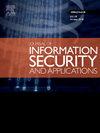Reversible data hiding in Redundancy-Free cipher images through pixel rotation and multi-MSB replacement
IF 3.8
2区 计算机科学
Q2 COMPUTER SCIENCE, INFORMATION SYSTEMS
Journal of Information Security and Applications
Pub Date : 2025-02-19
DOI:10.1016/j.jisa.2025.104003
引用次数: 0
Abstract
Reversible data hiding in encrypted images (RDH-EI) has gained significant attention as a solution to content security challenges in cloud-based image storage. A key challenge in this field is to achieve large-capacity data hiding directly within secure ciphertexts without relying on any redundancy. This paper proposes a scheme for achieving high-capacity reversible data hiding in ciphertext images without redundancy. By combining stream cipher XOR and pixel permutation encryption, the generated ciphertext eliminates redundant information, making it resistant to existing cryptographic attacks. In the data embedding phase, we first rotate the positions of pixels within the image blocks and adjust the arrangement of pixel bit-planes to effectively exploit spatial position features for reversible data hiding. Subsequently, we exploit the embedding potential of the central pixel by applying MSB replacement, further increasing the embedding capacity. We introduce a novel method for calculating image block complexity to enhance image recovery quality, considering pixel correlations within and between adjacent blocks. Experimental results show that the proposed RDH-EI scheme achieves a maximum embedding capacity close to 1 bpp, significantly higher than both classical and state-of-the-art algorithms. Moreover, the algorithm is resilient to potential attacks, such as forgery attacks.
通过像素旋转和多msb替换在无冗余密码图像中隐藏可逆数据
加密图像中的可逆数据隐藏(RDH-EI)作为一种解决基于云的图像存储中的内容安全挑战的解决方案已经引起了广泛关注。该领域的一个关键挑战是在不依赖任何冗余的情况下实现大容量数据直接隐藏在安全密文中。提出了一种实现无冗余的大容量可逆数据隐藏的方案。通过结合流密码异或和像素排列加密,生成的密文消除了冗余信息,使其能够抵抗现有的密码攻击。在数据嵌入阶段,我们首先旋转图像块内像素的位置,并调整像素位平面的排列,有效地利用空间位置特征进行可逆数据隐藏。随后,我们利用中心像元的嵌入潜力,采用MSB替换,进一步提高了嵌入容量。我们引入了一种新的计算图像块复杂度的方法来提高图像恢复质量,该方法考虑了相邻块内和相邻块之间的像素相关性。实验结果表明,所提出的RDH-EI方案实现了接近1 bpp的最大嵌入容量,显著高于经典算法和最新算法。此外,该算法对潜在的攻击(如伪造攻击)具有弹性。
本文章由计算机程序翻译,如有差异,请以英文原文为准。
求助全文
约1分钟内获得全文
求助全文
来源期刊

Journal of Information Security and Applications
Computer Science-Computer Networks and Communications
CiteScore
10.90
自引率
5.40%
发文量
206
审稿时长
56 days
期刊介绍:
Journal of Information Security and Applications (JISA) focuses on the original research and practice-driven applications with relevance to information security and applications. JISA provides a common linkage between a vibrant scientific and research community and industry professionals by offering a clear view on modern problems and challenges in information security, as well as identifying promising scientific and "best-practice" solutions. JISA issues offer a balance between original research work and innovative industrial approaches by internationally renowned information security experts and researchers.
 求助内容:
求助内容: 应助结果提醒方式:
应助结果提醒方式:


